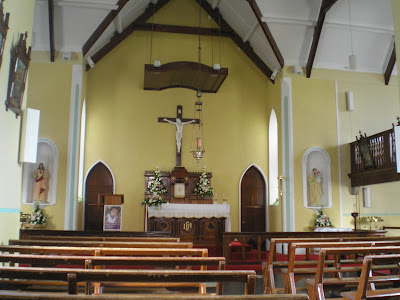2 November is the feast of Saint Erc of Slane, a saint who features in the hagiography of Saint Patrick. He also features in the hagiography of Ireland's patroness and below is an account of some of the miracles worked by Saint Brigid which include Bishop Erc, taken from Volume II of The Lives of the Irish Saints by John, Canon O'Hanlon. The stories testify to the friendship of the two saints as well as to the mutual respect which existed between them:
One of the holy men, who had been distinguished owing to his virtues in St. Brigid's time, was Bishop Erc or Ercus of Slane. He was an early convert and a disciple of St. Patrick. This Bishop Erc's immediate progenitors and family lived in Munster; although, he descended from Fergus Rogius, and the royal line of Ulster kings. His hermitage was at Slane, on the banks of the Boyne, and it stood in a most charming locality. Here too, at the present time, may be seen some most interesting relics of our ancestors' piety. Beside that romantically situated cell of the holy man, yet visited by so many pilgrims of taste, who delight to wander along the winding waters of the Boyne, some towering and extensive abbey ruins crown a magnificent height, which presents a vast view over one of the most lovely landscapes in Ireland.
With blessed Erc, the great St. Brigid was specially intimate and bound by ties of holy friendship. This appears from her Acts, and it is supposed, that about the year 484, she was his travelling companion to his native province. Such tour of the holy abbess possibly preceded one she made to Connaught although, indeed, this matter has not been very clearly established. St. Brigid entertained a great inclination to see certain consecrated places and holy persons in Munster; but, according to another account, her visit there was induced, through a desire to accompany St. Erc on a visit towards that country, where his relatives lived. One day, while prosecuting their journey, St. Brigid said to the bishop, "O venerable father, point out to me the quarter of Munster, in which your family resides." When the bishop had complied with her request, the holy virgin exclaimed in continuation, "At present, a war is there waging, between your tribe and another clan." The bishop replied to her: "O holy mother, I believe what thou hast told me is true, for when I last left them to see you, they were in a state of discord." Then Brigid cried out, "O Father, your people are now routed." One of St. Erc's disciples, hereupon, thoughtlessly remarked to the holy abbess, "How are you able to see the fight at such a distance?" The bishop reproved this incredulity for his not recognising the Holy Spirit's illuminating gifts conferred on a virgin, who was blessed both in soul and body. Then said Erc to our saint: "O servant of God, sign our eyes that we may witness those things thou seest." The spouse of Christ immediately complied with this request, so that they clearly observed the battle's progress. Looking on, in great grief, his disciple cried out to Bishop Erc: "Alas! also, my Lord, at this moment, my eyes behold the decapitation of two brothers." The result of enquiry established the reality this vision detailed.
Afterwards, in a certain place, and near a mountain, the holy Bishop Erc and the sanctified virgin Brigid sat down, with their attendants. These were greatly fatigued after their journey, and they experienced great hunger. A youth in their company thereupon remarked, that whoever gave them food should confer a great charity on them. St. Brigid then said, "I predict, that if food and drink be required, you must wait awhile in expectation of assistance from on high; because, I behold a house, in which they are to-day preparing alms for a certain church. Within an hour it shall come here, and even now it is put up for us in packages." While our saint was speaking, refreshment carriers arrived, and when they had learned the illustrious Brigid and holy Bishop Erc, with their disciples, were there, those bearers greatly rejoiced to relieve their wants. Alms were presented to the famished travellers, with such words: "Receive those refreshments, which God Himself hath intended for you, as your wants and merits should be taken into consideration, before those of any other congregation." Giving God thanks, our travellers partook of this food presented; yet, as they only received edibles, some drink was required, likewise, to allay their thirst. Then Brigid told them to dig the earth near this spot. On obeying her order, a spring of clear water issued from the ground. Afterwards, it bore the name of St. Brigid's well, and it might be seen at the time our virgin's Third and Fourth Lives had been written.
The holy travellers subsequently visited Magh-Femyn, at a time when a great Synod of Saints was there assembled. They were obliged to remain at that synod. The holy Bishop Erc gave an account of those miracles wrought by our saint, while he was assisting at this council. The neighbouring inhabitants, hearing that Brigid was there, brought many infirm persons to her, that she might heal them. Among these were included some lame, leprous, and demented persons. Such fortunate patients were released from their several afflictions, through Divine assistance, and the prayers of our merciful saint.
Dominica in Palmis - Palm Sunday
-
Palm Sunday is a privileged semi-double Sunday of the first class and the
sixth, and last, Sunday in Lent. Its liturgical colour is violet. No feast
can t...
3 hours ago








































































































